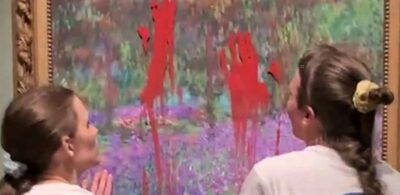The Eco-Extremist War on Art

A faction of the environmentalist movement has developed new plans for combating climate change. They’ve decided that disrupting art institutions with acts of “civil resistance” is a path to a sustainable future. The actions these “activists” engage in consists of spray-painting anti-oil graffiti on museum property and gluing themselves to the frames of masterpiece oil paintings. Few things describe cultural collapse like eco-extremists sacking classical Western art.
In Feb 2022 the “Just Stop Oil” faction was founded in the UK. They seem responsible for devising the tactic of assailing art museums and galleries to stop the UK Government from using and advancing fossil fuel. As a stratagem it is irrational and menacing; the faction launched anti-art actions against museums in the UK starting in June 2022. Allied groups like “Last Generation” followed suit by activating cells in Italy (Ultima Generazione) and Germany (Letzte Generation).
It is difficult to find a chronology of the eco-extremist war on art. Corporate media giants and the so-called art press have mostly been silent; let’s not forget the leftwing dictum, “silence is violence.” Consider this article a compendium. It preserves the history of anti-art deeds while providing a groundwork for research. I’ve arranged the examples by date, the most recent appear at the top of this article, with the oldest at the bottom.
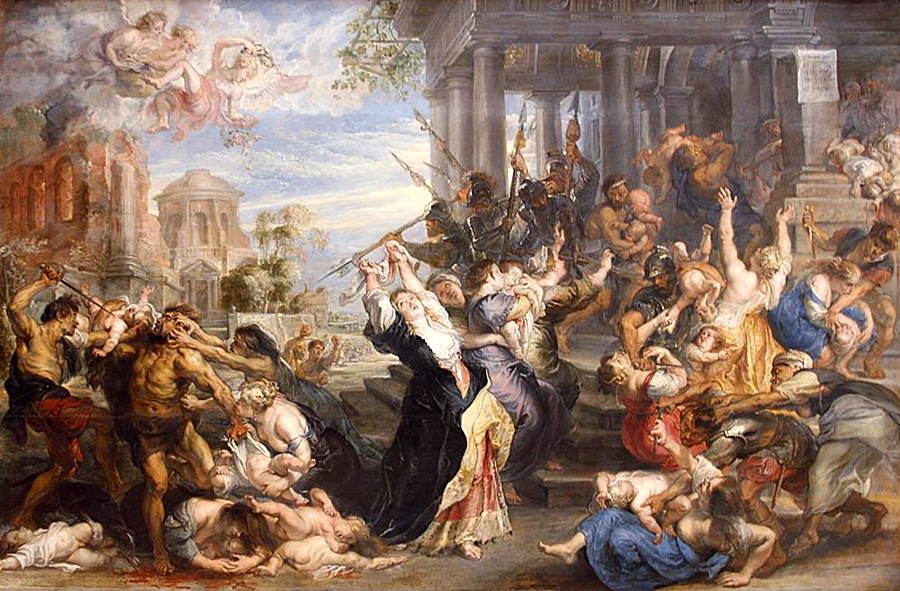
On Aug. 26, 2022, two members of the German group Letzte Generation (Last Generation), invaded the Alte Pinakothek Museum in Munich and superglued their hands to the antique frame of the 1638 oil painting Massacre of the Innocents by Peter Paul Rubens. The painting depicts the biblical story of Herod, King of Judea, who was visited by the Three Magi seeking “the one who has been born king of the Jews.” Fearing a competing king, Herod ordered the killing of all male children in Bethlehem who were two years old or under.
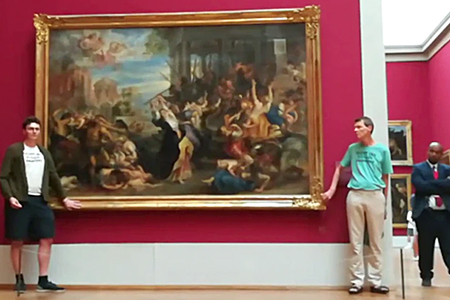
Letzte Generation twisted the story to fit their apocalyptic climate collapse agenda. They released a statement that read in part: “Climate Catastrophe is as visible as the knives of King Herod’s child-murdering soldiers. In the painting, infants are torn from their mothers and bloodily murdered on King Herod’s orders. The Climate Catastrophe affects everyone elementarily and may lead to war, which would also destroy art.”
Bernhard Maaz, Director General of the Bavarian State Painting Collections, denounced the eco-vandals: “It is not legitimate to damage unique cultural evidence of humanity in order to point out the actual climatic problems.” Police detained the two extremists and charged them with property damage.
On Aug. 25, 2022, two members of the Letzte Generation group invaded the Gemäldegalerie (Painting Gallery) of Berlin. They superglued their hands to the frame of Rest on the Flight into Egypt, an oil painting by German Renaissance artist Lucas Cranach the Elder (1472-1553).
Cranach was a leading printmaker and painter who followed Martin Luther, the priest who in 1517 nailed his theses to the door of All Saint’s Church in Wittenberg in protest of selling papal indulgences. That act set off a public debate that sparked the Reformation.
Cranach was thirty-two when he painted Rest on the Flight into Egypt. The painting depicts Mary with the Christ child standing on her knee as cherubs play music and frolic at Mary’s feet. Joseph stands in the background like a guard. The background is novel—it’s inspired by Germany’s forest lands.
The eco-extremists released a statement: “Mary, Joseph and Jesus were on their way to safe haven. Humanity, however, is on the fast track to deadly Climate Catastrophe.”
The German Cultural Council (Deutscher Kulturrat), an umbrella group for cultural organizations, blasted the eco-extremists. The Council’s managing director Olaf Zimmerman said:
“I say clearly that the act of gluing themselves to the frames of famous works of art is clearly wrong. The risk of damaging the artworks is very high. The works put in danger are part of world cultural heritage and deserve to be protected as well as our climate.”
If only international media and art world elites would say as much.
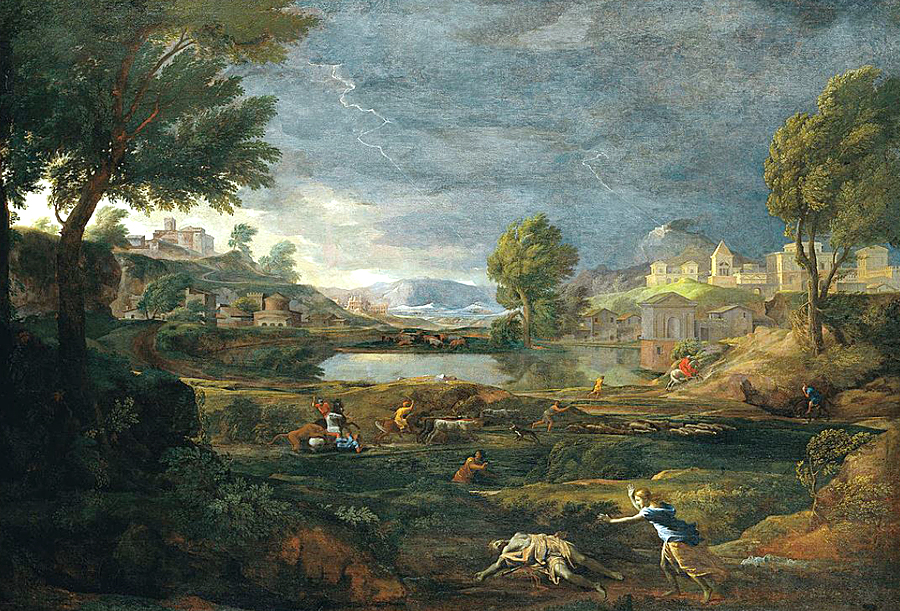
On Aug. 24, 2022, two members of Letzte Generation invaded the Städel Museum in Frankfurt, Germany. They superglued their hands to the frame of the 1651 oil on canvas painting Thunderstorm with Pyramus and Thisbe by classical French Baroque painter Nicolas Poussin.

Poussin based this painting on Metamorphoses, the magnum opus written by the Roman poet Ovid in 8 AD. One of the tales the poet told was the tragic love story of Pyramus and Thisbe.
The lovers, forbidden to wed by their parents, agreed to a secret meeting by a tree. Thisbe arrived first but fled when she saw a lioness bloody from a fresh kill; as Thisbe escaped she dropped her cloak. The lioness pawed the cloak leaving it bloody. When Pyramus turned up he found the bloody cloak and concluded a wild beast had devoured his love, so he killed himself with his sword. Thisbe returned, found her lover dead, and in her grief killed herself with the same sword.
Letzte Generation philistines contorted the theme of Poussin’s painting to fit their cult agenda; their statement read: “Today the picture is symbolic of the destructive course of current politics: it shows Pyramus lying on the ground, next to him a sword with which he threw himself to his death based on erroneous assumptions. Just as Pyramus made false assumptions, our government is also making false assumptions that will lead our societies to collapse.”
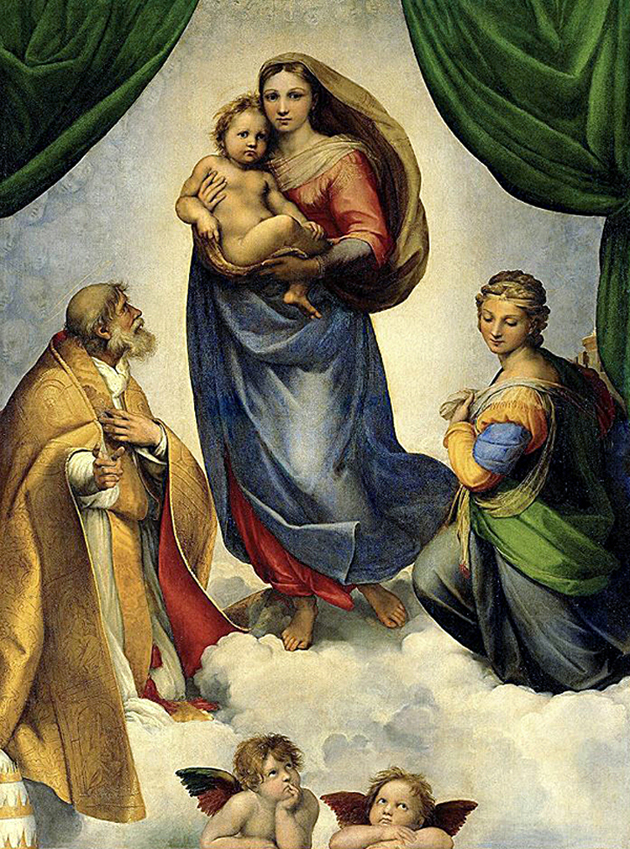
On Aug. 23, 2022, two members of Letzte Generation entered the Gemäldegalerie Alte Meister (Old Masters Picture Gallery) in Dresden, Germany. They assailed the painting The Sistine Madonna.
Created by Renaissance artist Raphael in the years 1512 to 1513, it is one of Europe’s most famous Christian altarpieces. The extremists stepped over the small rope barricade disallowing viewers from getting too close to the painting, and superglued their hands to the painting’s elaborate antique frame. Authorities said the painting was unharmed but its frame was damaged. Police arrested the vandals.
Pope Julius, who served from 1503 to 1513, commissioned Raphael to create the altarpiece for the church of San Sisto in Piacenza, Italy. That church venerated the martyrs Pope Sixtus II and Saint Barbara. Pope Sixtus II was bishop of Rome when Roman Emperor Valerian ordered all Christian bishops, priests, and deacons executed; Sixtus was the first to be martyred on August 6, 258. Saint Barbara was an early Christian in the city of Heliopolis, Phoenicia (now Syria and Lebanon). She was executed by pagans in 200 AD for refusing to renounce her Christian faith.
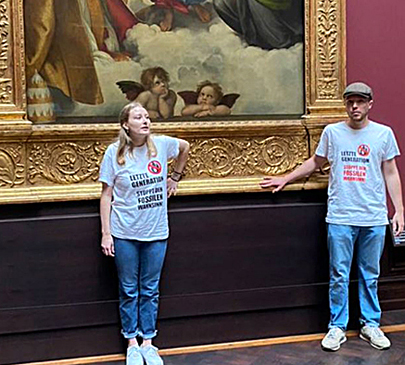
In his altarpiece Raphael painted the Madonna carrying the Christ child into the world; behind Mary the faces of cherubs make up the clouds. Pope Sixtus II is pictured on the left, Saint Barbara is on the right. At the bottom of the painting Raphael painted two cherubs; the two are likely the most reproduced cherubim in Western art history.
Twisting the altarpiece into the new religion of environmentalism, Letzte Generation issued a statement that said: “Mary and Jesus look to the future with fear. They look forward to Christ’s death on the cross. An equally predictable death will also be the result of the climate collapse.”
The Letzte Generation website posted a headline describing their attack on Raphael’s painting, it read “Stuck to Painting – Resistance to Sistine Madonna.” I’m far from being a Christian theologist but these fanatics just alienated every Christian on the planet. Resistance to the Mother of Christ stops climate change?
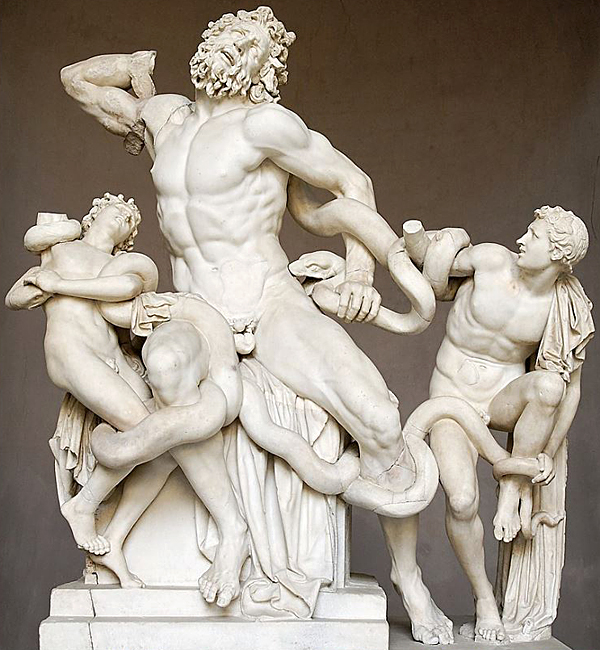
On August 22, 2022, three members of Ultima Generazione (Last Generation) invaded the Vatican Museums located on the grounds of Vatican City in Rome, Italy. Two used superglue to cement their hands to the marble base supporting the Greek marble statue, Laocoön and his Sons. The third extremist unfurled a banner that read when translated from Italian: “Last Generation—No Gas and No Coal.” The sculpture was created around 200 BC by three eminent artists from Rhodes, Greece. Their names were Agesander, Polydorus, and Athenodorus.
I once visited the Vatican Museums, they are comprised of twenty-four separate galleries with various collections; the Sistine Chapel with Michelangelo’s murals is one of the galleries. Walking from gallery to gallery I soon stood all alone before the long suffering marble giant Laocoön and his tormented sons Antiphantes and Thymbraeus. We must have conversed on the subject of affliction without hope of redemption for at least an hour.

For years in my mind’s eye I imagined those biting serpents sent by the gods, torturing the ill-fated trio. Now I see something much more horrendous… blank-eyed, muddleheaded lowbrows grasping at an ancient marble wonder with superglue soaked hands.
On Aug. 21, 2022, four Ultima Generazione cadre entered the Scrovegni Chapel in Padua, Italy, where world-renowned murals by Giotto di Bondone (1267-1337) are a major tourist attraction. Putting aside their usual tricks of spray-paint and superglue, the eco-extremists tried a new tactic. They came with lengths of heavy duty steel chain and padlocks without keys.
Two members each wrapped a length of chain around their waists and locked it in place with a padlock, the other end of the chains were locked to the metal guardrail keeping viewers from Giotto’s murals. The cult members then read a prepared script about fossil fuel causing the end of the world, while the other two cultists filmed the stunt.
Police arrived with a bolt cutter designed to cut chain, they removed the shackles and carted the zealots off to jail. It was a lackluster “protest” for saving the earth. Still, I can’t help but think that leaving the extremists locked up in chains and securely fastened to the metal balustrade, should have been their punishment.
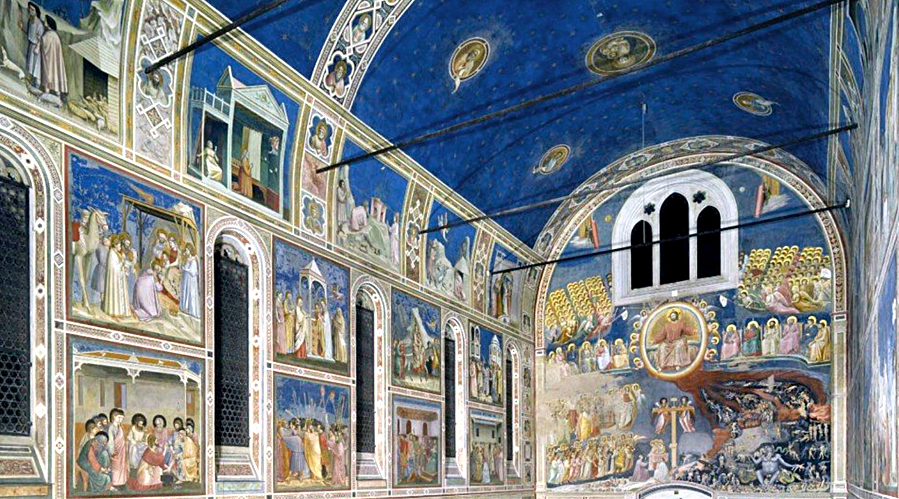
Giotto covered the interior of Scrovegni Chapel with murals depicting the life of Christ and the Virgin Mary. From 1303 to 1310 he painted a total of 39 dazzling mural scenes. They were commissioned by a banker named Scrovegni, who was responsible for building of the Chapel.
A brilliant artist, Giotto was of the Gothic world, but his naturalism heralded the coming Renaissance. In 2021 the United Nations Educational Scientific and Cultural Organization (UNESCO), proclaimed Padua’s 14th-century fresco murals, including Giotto’s at the Scrovegni Chapel, to be of “outstanding universal value” and part of UNESCOs heritage sites. None of that mattered to the extremists of Ultima Generazione.
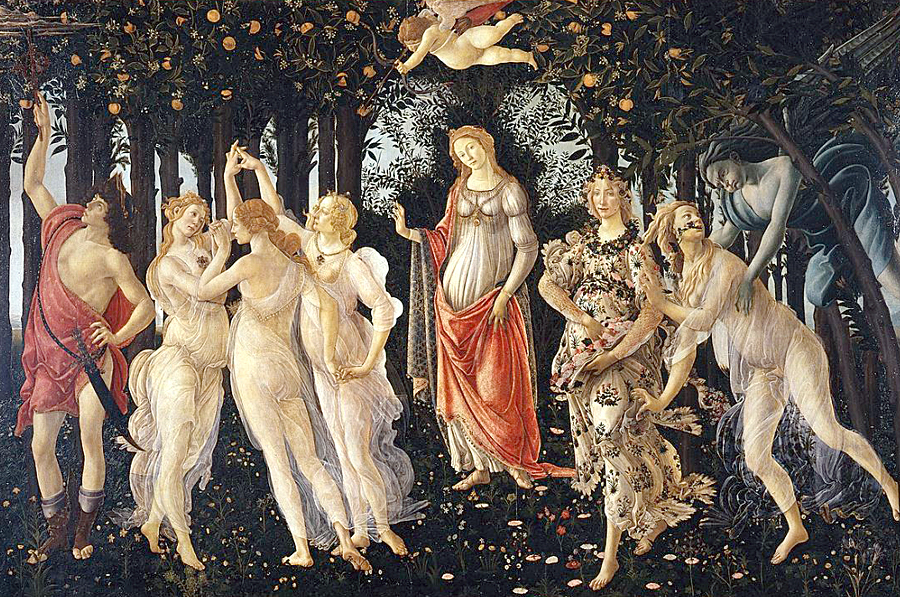
On July 22, 2022, three members of Ultima Generazione entered the Uffizi Gallery in Florence, Italy. They assailed La Primavera (Spring), a famous tempera on wood painting created circa 1477-1482 by Sandro Botticelli. One extremist unfurled a banner reading “Ultima Generazione—No Gas and No Coal,” as two others each glued their hands to the heavy glass shield protecting the painting. Spring is paired with Botticelli’s tempera on canvas painting Birth of Venus, created by the artist in 1485; both works hang in the same room and are thankfully protected by glass shielding.
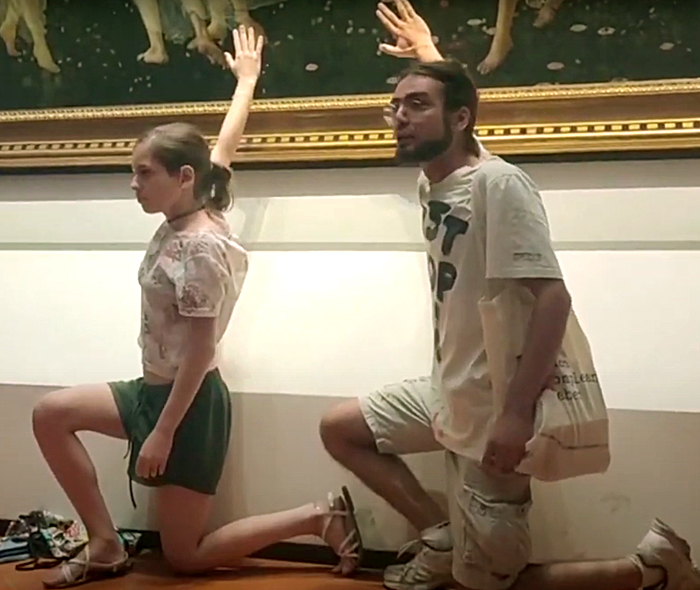
Dozens of museum goers watched passively as the vandals mounted their assault. Not a single person moved to defend the masterwork, save for an alert security guard who was undoubtably aware that Just Stop Oil had previously damaged a John Constable painting in the National Gallery of London (details later in this article).
Before the glue dried on the glass the guard pulled the two vandals away from the painting, tossed them on the floor, dragged them away from the area and arrested them. The three vandals were taken to a police station and given orders to stay out of Florence for three years. My verdict would have been harsher.
Ultima Generazione released a statement in which they asked: “Is it possible to see a spring as beautiful as this today?” A ridiculous question, though the answer is yes… you can see as wondrous a spring nowadays. Despite the fatalism of the extremists our planet is still a beautiful place. But one wonders, why does their critique stop at the Western world?
Today the most polluted cities on earth are not in the US, the UK, or Europe, they are in China, Pakistan, and India. China is building more than three times the number of coal power plants than exist in all of the nations of the world combined. Yet the eco-extremists are silent.
In 2001 president Bill Clinton made possible China’s entry into the World Trade Organization; it was thought the WTO would reform China’s communist regime, moving it towards democracy. See how well that worked? US factories producing all types of goods began moving to China for its low-wage workers.
42,400 manufacturing plants closed in the US from 2001 to 2009; the great majority never reopened in the US. Some 2.3 million American factory workers lost their jobs. Today China makes the windmills and batteries for electric vehicles needed by Americans and Europeans. But don’t worry, eco-extremists have the answer—disrupt Western art museums!
In a statement Ultima Generazione said they “decided to use art to sound an alarm call: we are heading towards social and eco-climate collapse.” Their Uffizi outburst was the start of “a new season of actions” targeting museums. First of all they are not using art, they are abusing it. If they possessed artistic skill they might have created their own art, but they’re only capable of gluing themselves to the frames of masterpiece paintings. They drag us all into the new dark ages.
I visited the Uffizi as a young artist in 1972 and stood awestruck before Spring and the Birth of Venus. I bought a large print of Spring from the Uffizi, it still hangs in my home today. I was amazed at how Botticelli used gold-leaf in Birth of Venus, every green leaf is outlined with it, it’s also found in the wings of the wind gods Zephyr and Aura the artist depicted in the painting. Botticelli had a huge influence upon me as a young artist, it saddens me that the eco-extremists can only imagine Botticelli’s work as a prop in a propaganda stunt.

On July 5, 2022 five vandals from Just Stop Oil targeted a copy of The Last Supper located at the Royal Academy of Arts in London. The copy was painted circa 1515 by Giampietrino and perhaps by Giovanni Antonio Boltraffio, both students of Leonardo Da Vinci. Before all five eco-extremists glued themselves to the frame of the huge painting, they spray-painted “No New Oil” on the wall beneath it. The police arrested all five for criminal damage. Members of Just Stop Oil often spray-paint the walls and floors of museums during their actions.
Spray-paints contain solvents associated with paint thinners. I can’t imagine spraying solvent aerosols anywhere near historic paintings! Despite their high-mindedness, or is that “hive-mindedness,” these bughouse environmentalists don’t care about the harm they bring about… they have a higher cause.
The group targeted The Last Supper because they believe fossil fuel will cause global temperatures to rise, with a global food crisis resulting (Get it? Christ’s last meal). My guess is the extremists haven’t heard petroleum is a main component of petrochemical fertilizers and pesticides, without which the global population would likely starve. Then again, maybe Just Stop Oil is hoping for a radical population reduction. Here’s another conundrum. All methods of transport that deliver food to population centers, trucks, airplanes, trains, cargo ship freighters, are reliant upon, not wind power, but fossil fuel.
Don’t expect the brainiacs of Just Stop Oil to find an alternative, they’re stuck on wind and solar power as the answer to our energy problems. Incidentally, the American Eagle Foundation reported that in 2013 an estimated 573,000 birds were killed in the US by wind turbines—and that was before the craze to build multi-acre wind farms. In April 2022 news agencies reported a single US provider of wind power pleaded guilty to its wind turbines killing upwards of 150 American eagles on its renewable energy wind farms. That’s the future of wind power… the extinction of the Golden and Bald Eagles. How apropos.
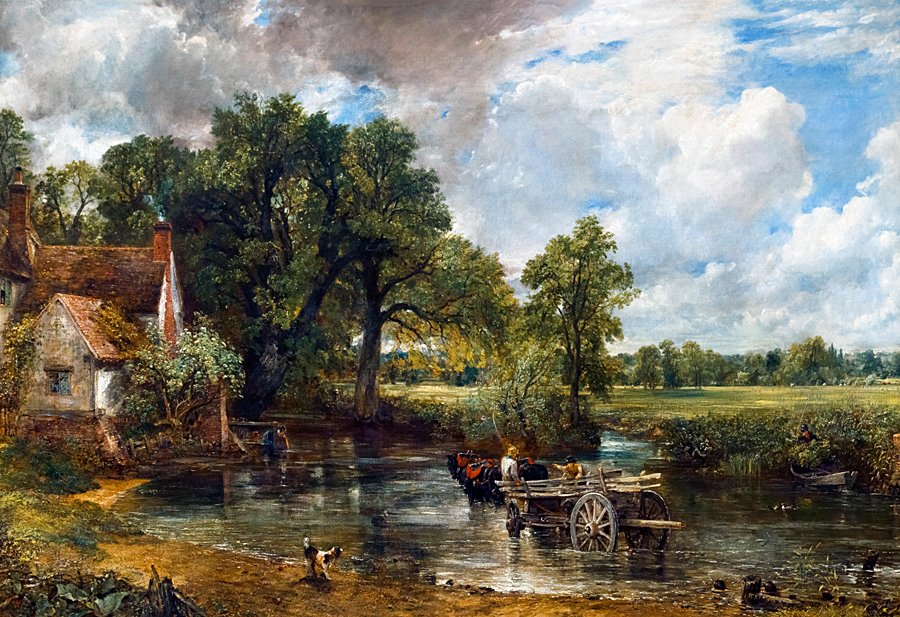
On July 4, 2022 two members of Just Stop Oil invaded the National Gallery in London and beset the 1821 oil painting The Hay Wain by John Constable (1776-1837). The landscape depicts the countryside between Suffolk and Essex. Three horses are pulling a hay wain (a cart meant to carry hay) across a millpond on the river Stour. On the horizon farmers harvest hay. Lost in the rushes on the right is a man with a fishing pole, his boat moored to the shore; ducks placidly swim in the gentle river. On the left is the Cottage home of tenant farmer Willy Lott, which still stands today, now owned by the National Trust.
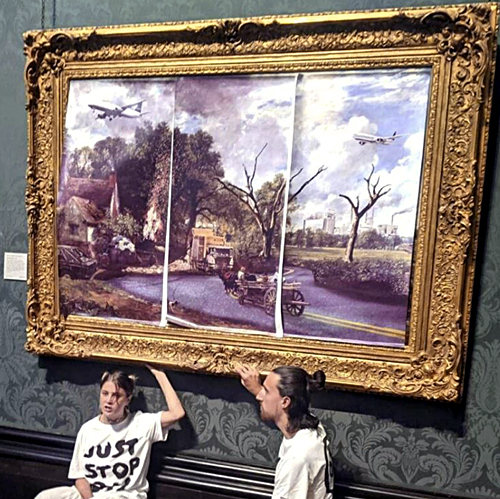
Before their raid the vandals used a digital application to create a photomontage, in their words it depicted a “nightmare scene that shows how oil will destroy our countryside.” The vandals had measured the internal dimensions of the frame around Constable’s painting, making sure a print of their montage would fit the space.
The montage was printed-out on three separate sheets of paper that when placed together side-by-side created the complete image. As banal as today’s street art, the montage switched out the river for an asphalt road. An old washing machine filled the hay wain, a junk car sat in front of the old Cottage, and the trees were dead. The farmers were replaced with industrial buildings belching pollution. Commercial jets filled the sky.
Horror of horrors, the goons applied adhesive to the back of their printouts and glued them directly onto the Constable painting! The two vandals then sat beneath the painting and glued their hands to the picture frame. Together they recited the reasons for their actions and were eventually arrested. The National Gallery later said glue had caused damage to the artwork’s antique frame, more importantly it created limited damage to the varnished surface of the painting.
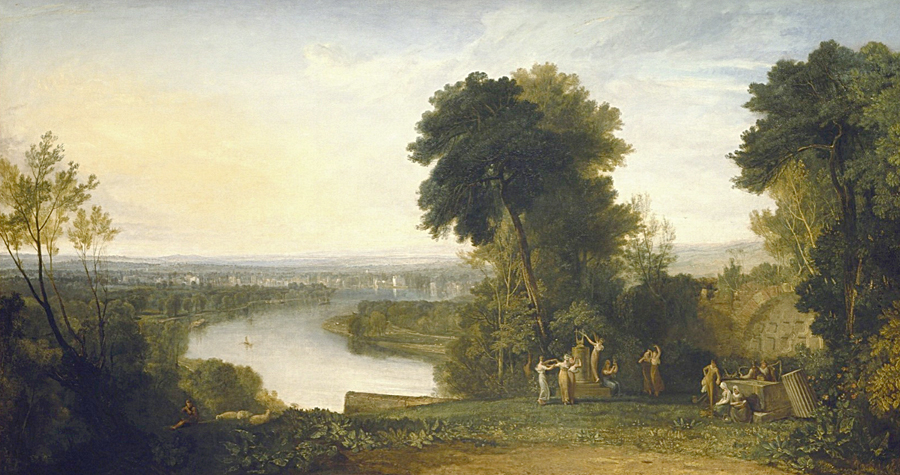
On July 1, 2022, two members of Just Stop Oil invaded the Manchester Art Gallery and descended upon Thomson’s Aeolian Harp, an oil painting by JMW Turner (1775-1851). On the parquet flooring beneath the painting the hoodlums spray-painted in purple “No New Oil.” Next to that they spray-painted in orange a death’s head—the logo for Just Stop Oil (a skull is the perfect icon for the group). The two vandals then glued one of their hands to the painting’s frame. They were arrested for their criminal acts.
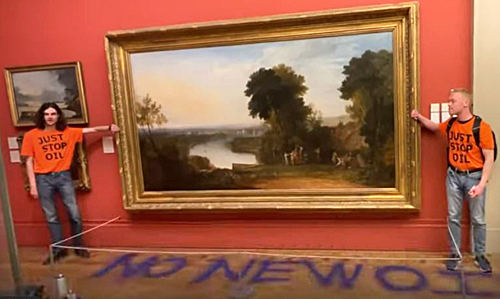
Turner’s 1809 Thomson’s Aeolian Harp celebrated the Scottish poet James Thomson (1700-1748), who wrote the poem An Ode to Aeolus’ Harp. In Greek mythology Aeolus was the King of Wind, and the ancient Greeks created aeolian harps made of wood and gut strings that were played by the wind.
In the 1600’s Europeans rediscovered the aeolian harp and by the end of the 18th century the curious harp became popular in the Romantic era. A number of poets wrote about the harp and its ethereal sounds. Polish pianist Frédéric Chopin (1810-1849) wrote the composition Etude Op.25 No.1 Aeolian Harp.
Thomson’s Aeolian Harp was unlike Turner’s richly colored atmospheric and gossamer-like paintings of his later years, works like the 1834 oil painting The Burning of the Houses of Lords and Commons. Turner painted the fiery scene after he witnessed the UK Parliament burning. By comparison Aeolian Harp was almost an example of art from the French Academie. Its background depicts the River Thames while the foreground presents a group of women in 18th century dress dancing around an aeolian harp sitting on a pedestal. Too small to see in this essay’s illustration, Turner painted a name carved into the pedestal’s base, ”Thomson,” a visual eulogy to the late poet.
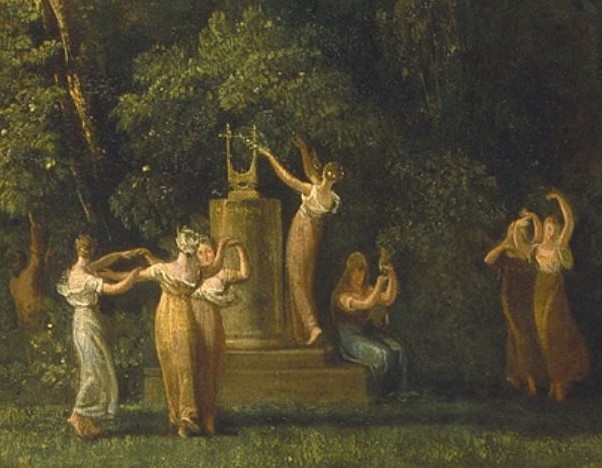
While glued to the painting’s frame, one vandal made a statement on climate collapse to members of the media, who just happened to be there when the totally unexpected event occurred: “By refusing to use its power and influence to help end this madness, the art establishment is complicit in genocide. Directors of art institutions should be calling on the government to stop all new oil and gas projects immediately.”
It must be noted that the Manchester opened a wing called the Climate Justice Gallery, where they display enough politically correct art to choke an entire herd of methane gas producing cows. The gallery also launched a program called CLIMAVORE. In their words: “This long-term project is changing the food offering across cultural institutions with dishes using ingredients that address the climate emergency.” None of this matters to Just Stop Oil, who regard the Manchester Art Gallery as an institution “complicit in genocide.”
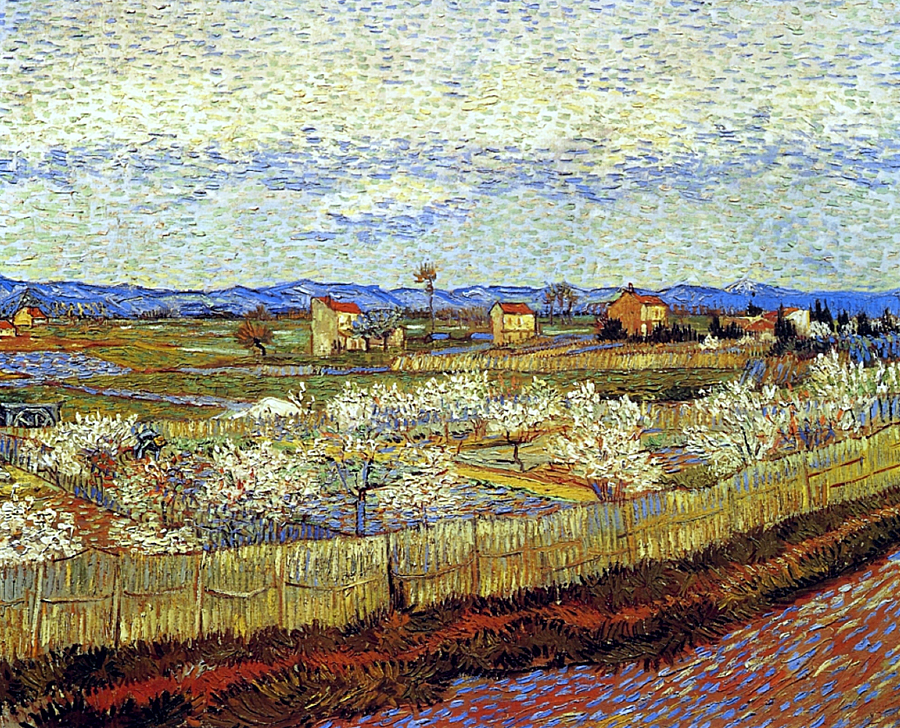
On June 30, 2022 three members of Just Stop Oil invaded the Courtauld Institute of Art in London. Two members glued the palms of their hands to the antique wooden picture frame holding Peach Trees in Blossom, an oil painting created in 1889 by Dutch artist Vincent van Gogh (1853-1890). The extremists targeted Van Gogh’s landscape of Arles in France because, they insist, the land in the painting will soon be completely devastated by climate change.

While glued to the frame of the painting one of the extremists told the media: “It is immoral for cultural institutions to stand by and watch whilst our society descends into collapse. Galleries should close. Directors of art institutions should be calling on the government to stop all new oil and gas projects immediately. We are either in resistance or we are complicit.” The other delinquent added: “Artists and the art establishment are failing us by focusing on the wrong things. We need everyone to focus on the government’s genocidal plans to allow fossil fuel companies to drill for more oil. This is one of the greatest injustices in history. We must resist.”
So artists are focusing on the wrong things are they? Well I hope they continue to focus on the wrong things, just as they always have done. Nevertheless, the vandals who assailed the Van Gogh were charged with having caused £2,200 ($2,583) worth of damage to the painting’s frame. Their trial takes Nov. 22, 2022.

On June 29th, 2022, three Just Stop Oil vandals invaded the Kelvingrove Art Gallery and Museum in Glasgow, Scotland. Wearing “Just Stop Oil” T-shirts they used stencils and spray-paint to graffiti the group’s name on the wall and floor of the museum. Afterwards two glued the palms of their hands to the antique frame around the oil painting My Heart’s In The Homeland, created in 1860 by one of Scotland’s greatest painters, Horatio McCulloch (1805-1867).

Two of the vandals were art students, which tells you a lot about today’s art schools. One ineloquently said of the group’s actions:
“By doing this we bring attention by targeting cultural artifacts, we bring attention to the issue because people will see this and then they’ll get angry but then maybe they’ll think about why they’re angry and why we’re doing this and how things got to this point” (she could write speeches for Kamala Harris). That student and her cohorts want you to think the world is ending because of oil drilling, and the best way to alert the public is by… targeting cultural artifacts. Maybe a good, sensible book burning comes next?
The other vandal involved in the gluing rebuked Horatio McCulloch as a class enemy. She noted that he painted his landscape in 1860, “when whole crofting communities (small land tenants) were evicted by a new class of landlords ruthlessly pursuing their own private interests. It was only when crofters (tenant farmers) organized and resisted that they won rights (…) we must learn from the history of Scottish crofters on how to fight back effectively.” Evidently “fight back” now means “trash museums.” All five zealots were arrested at the Kelvingrove for their reckless behavior.

Of course Just Stop Oil’s twitter account promotes vandalism and attacking art. Take their July 8, 2022 tweet for example; it starts with a statement about climate change “destroying our only home” and ends with a call to pillage art: “The Suffragettes slashed paintings for the right to vote. Just Stop Oil.”
The anti-art tweet featured an unidentified painting, it was the Rokeby Venus by Spanish artist Velázquez. On March 10, 1914 the Rokeby Venus was slashed 5 times with a meat cleaver by a suffragette named Mary Richardson, or “Slasher Mary” as she came to be known.
Her act was retaliation for the UK government’s 1913 arrest, trial, and conviction of leading suffragette Emmeline Pankhurst, who had taken credit for the bombing of the summer home of David Lloyd George, head of Her Majesty’s Treasury and future Prime Minister of the UK. Pankhurst founded the militant Women’s Social and Political Union (WSPU), and its members reacted violently to her jailing.
Slasher Mary Richardson explained her cleaving the Rokeby Venus by saying: “I have tried to destroy the picture of the most beautiful woman in mythological history as a protest against the government for destroying Mrs Pankhurst, who is the most beautiful character in modern history. Justice is an element of beauty as much as color and outline on canvas.” Slasher Mary was given the maximum sentence for destroying an artwork, six months imprisonment.
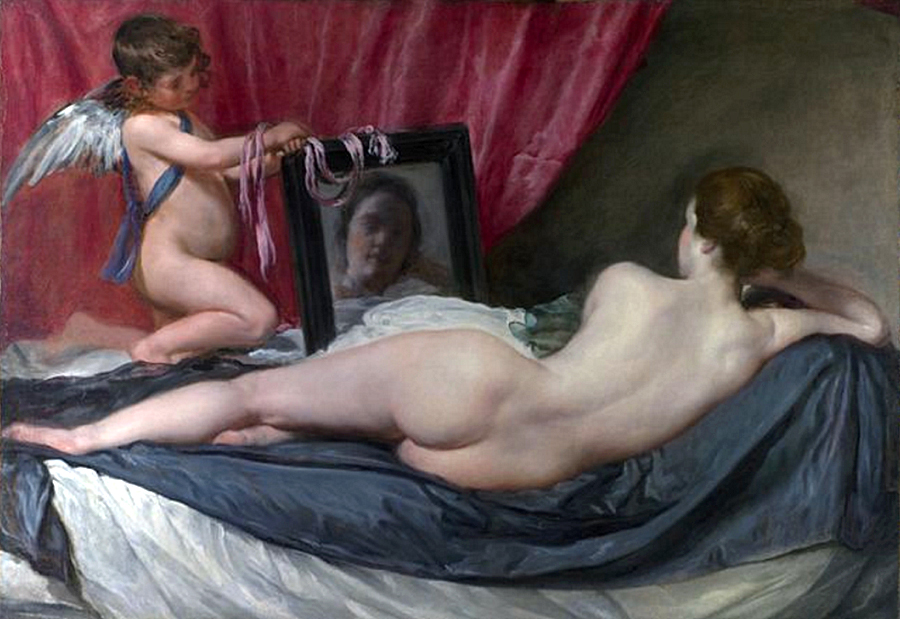
The Rokeby Venus, painted around 1647, portrays the Roman goddess of beauty and love named Venus. In the painting she looks into a mirror held by her son Cupid, god of erotic love. Scholar and art lover John Morrit purchased the canvas in 1813 for £500 (around $600). He wanted it for his home in Rokeby Park, Yorkshire; ever since it’s been known as the Rokeby Venus, despite originally being titled La Venus del Espejo by Velázquez.
In 1906 the Rokeby Venus became part of London’s National Gallery collection, and housed there ever since. Thankfully after Slasher Mary did her dirty work, the painting was restored by Helmut Ruhemann. In 1933 the Nazis took power and Ruhemann was fired from the Kaiser Fredrich Museum in Berlin because he was Jewish. Fearing for his life he left Germany in ’33 and moved to the UK where he began work as Art Restorer for the National Gallery in 1934—a position he held until 1972.
It’s difficult to verify but it appears Ruhemann restored the Rokeby Venus in 1934; at any rate he’s credited with the restoration. There is irony in Ruhemann’s story. In ’33 he fled the Nazis for the UK and ended up restoring a painting ruined by suffragette Mary Richardson—who in ’33 joined the largest pro-Hitler organization in England, the British Union of Fascists.

Just Stop Oil praised Mary Richardson for slashing the Rokeby Venus yet forgot to mention she later joined the British Union of Fascists, and she moved up the ranks to became the Chief Organizer of that party’s Women’s Section.
Today the suffragettes are seen as reformers who worked for the right of women to vote. Forgotten is the military blitz carried out by the Women’s Social and Political Union. Between 1913 and 1914 they carried out hundreds of bombing and arson attacks, 5 people were killed and some 24 were injured; today we call this terrorism. The first bombing in Ireland wasn’t carried out by the Irish Republican Army, it was executed by four WSPU members who bombed the Christ Church Cathedral in Lisburn, Ireland on July 31, 1914.
Just Stop Oil deceitfully glorifies Richardson for vandalizing art while keeping secret her membership in the British Union of Fascists. Cheering for suffragettes who attacked paintings is one thing, but what will the eco-extremists do when their acts of “civil resistance” fail to bring victory? Will they expand their campaign to include the violence once used by their suffragette superheroes? After all, Just Stop Oil claims to be combating government plans for genocide.
Some final remarks. Let me correct a fallacy regarding oil painting, it is not based on petroleum products. Oil paints are made from mineral pigments ground up and mixed with linseed oil—which is pressed from the seeds of flax plants. Turpentine, used to thin oil paints, is distilled from tree resin. The oil industry began in earnest in the early 20th century. Who thinks Rembrandt created his works with paint provided by the petroleum industry? I’ll give you a hint. Years ago in an online art forum environmentalists assailed me for causing climate collapse because I use “oil paints.”
Who funds Just Stop Oil? In April 2022 the Guardian reported the extremists “received hundreds of thousands of dollars from the Los Angeles-based Climate Emergency Fund (CEF).” CEF’s executive director was quoted saying this about Just Stop Oil: “We’re their lead institutional funder, I think actually their exclusive institutional funder at this point.”
In Aug. 2022 the New York Times filed a similar report saying the faction received close to $1 million from CEF to pay the salaries of 40 organizers. So who funds the CEF? The Guardian and the NYT said heirs from the Getty and Rockefeller families—who made untold billions from their holdings in the global petroleum industry, are top funders. Keep that in mind when pondering eco-extremists vandalizing museums and their art treasures.
I knew we were in trouble in 1989 when I viewed Tim Burton’s Batman in a movie theater. Jack Nicholson played the Joker, and in one scene Joker led his goons into Gotham City Museum to destroy its collection of masterpiece paintings. The gang spray-painted doodles on the canvases, and threw buckets of wet paint onto the works of Degas, Renoir, and other renowned artists.
However, the film’s nihilistic museum frolic didn’t upset me as much as the audience reaction. When seeing works of art busted-up, graffitied, and splashed with paint… the moviegoers roared with laughter. I never forgot that laughter, it was enthusiastic approval for the destruction of art.
____________
UPDATE: On June 13, 2023, the two members of Ultima Generazione that superglued their hands directly onto the base of the statue Laocoön and His Sons, were convicted of “aggravated damage” by a Vatican court. The vandals were ordered to pay more than $30,000 in restitution.
On Nov. 24, 2022 Deutsche Welle reported that dozens of police officers conducted raids on the homes of Letzte Generation members in Saxony, concerning eco-extremist attacks on Rafael’s Sistine Madonna painting in Dresden’s Old Masters Gallery. Three eco-extremists are charged with “damage to property.” The Old Masters Gallery put their overall financial losses from the attack at €12,000 ($12,482.04 US dollars). Around 60 police officers also conducted raids in Leipzig searching for evidence of criminal vandalism committed by Letzte Generation.



